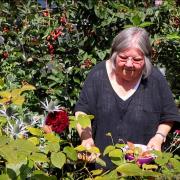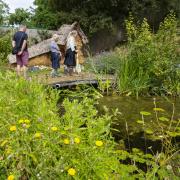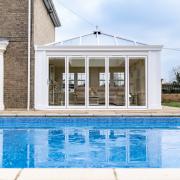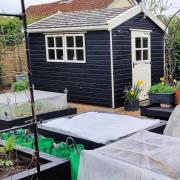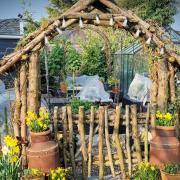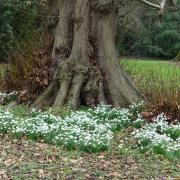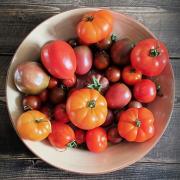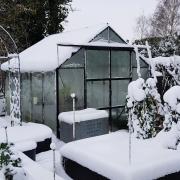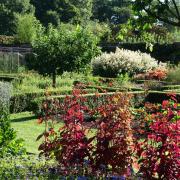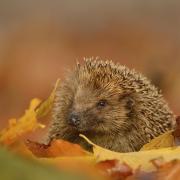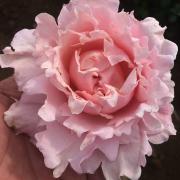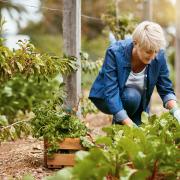Marion Welham explains how to bring the beach to your garden even if you live nowhere near the coast

Those of us lucky enough to have a garden may well have spent the past captive few months focusing on every flower that emerges, every bird that visits the feeders and every pollinator alighting on our plants.
During the lockdown that started March 23, I’ve seen lone bees collecting early sources of pollen, watched doves sitting patiently on a rickety nest only to lose their two squabs in a cruel May frost, and cursed a bitter east wind snapping the branches of a handsome rowan.
I’ve also come to appreciate our gravel garden for the shapes, textures and colours that draw the eye in all seasons – our own bit of beach when we were forbidden to go to the seaside.
As a bit of a beach bum in an earlier life, I’ve long had a fascination with the way seaside plants establish themselves in sand and shingle and endure extremes of wind, temperature and salt. Just how do they survive?

While studying horticulture, I learned that dunes are created by wind-blown sand trapped by beach grasses whose tough roots provide stability for strong-growing marram grass. As salinity reduces further inland, the dunes become more stable, creating conditions for yet more plants which in turn decompose, thus providing nutrients to nourish the next generation. And so it goes on.
Suffolk’s wonderful coastal dunes and shingle ridges are strung out in five narrow bands from Landguard to Corton, north of Lowestoft. Orford Ness has the largest vegetated shingle spit in Europe but nearer to my own home is the vast Kessingland beach with its distinctive strips of vegetated shingle.
Close to the sea, marram grass is punctuated by great stands of the smoky blue-green sea kale Crambe maritima and wrinkly star-shaped clusters of silvery foliage that give way to the bright yellow-horned poppy. The spreading sea purslane, has tiny waxy leaves like little pagodas, while the suckering sea pea with its vivid magenta flowers is rare in Britain but abundant on our local Suffolk shoreline.
Further inland is the white sea campion and the yellow tree lupins for which Kessingland is famous, due to George ‘Lupinseed’ Staunton who apparently sowed acres of them at the start of the 20th century when he realised they helped to bind together the shifting sands as a form of sea defence.

You may think these plants should inform choices for your own beach garden but, unless you actually live at the seaside and need to take account of salt-laden winds, you have a much wider palette to choose from. You need only look at the now world-famous garden Beth Chatto created from a car park just over the Essex border at Elmstead Market to realise those of us who garden inland can have a beach garden without limits.
If you’re on Mid Suffolk boulder clay, you might have to settle for prize-winning roses, but with light sandy soil you’re on a winner when it comes to creating your own little beach, even if you don’t live near the sea. And there are plenty of us in Suffolk. Roughly speaking, we are east of Ipswich, down to Felixstowe and around the Deben at Woodbridge, then up the coast to Snape and further on to Lowestoft, stretching along the Waveney as far as Beccles.
Then there are the Brecks, once holding the dubious distinction of having the most rabbits in the country. I once interviewed botanists Yvonne and David Leonard at their ‘Crossbills’ garden in Mildenhall. They seemed to have everything against them: sandy soil, a drying wind and greedy Scots pines, but their garden was a dazzling mosaic of Mediterranean plants as well as some of the native Breckland plants on which Yvonne is an authority.
For our own beach shingle garden, we chose a sunny area between our conservatory and my studio. First we had to hire a pneumatic drill to rip into the concrete laid by the previous owner. This revealed a depressing barren wasteland of stony, sandy dirt so our next move was to lay our hands on whatever organic matter we could as well as leaf mould just to give plants a reasonable start. If you are taking over an existing border or a lawn, you’ll want to remove any weeds at this stage.

We then dutifully laid permeable landscape fabric before applying a shingle mulch of about 5cm but I’m now in two minds about this. The membrane is useful at the beginning before intended plants get established and unwanted weeds emerge, but I’m now more relaxed about it and positively encourage self-seeders. Whenever I see a corner of ugly black membrane sticking out of the gravel, I yank it out and have since been rewarded with self-seeding orange Icelandic poppies, first planted in 2012, pretty purple and pink Linaria, hopefully now with us forever, and wild foxgloves that positively thrive in these conditions. New planting is also easier when you don’t have to cut holes in a membrane.
Once your plants are in, it’s fun to add a few larger pebbles, some seashells and perhaps some bowls of sedums then sit and enjoy your beach without feeling in the least bit guilty as there’s little else to do. A sunny spot, no watering, very little weeding, and a bit of thinning is all that’s required. So much reward for so little effort.
Marion Welham gardens on sandy soil in north Suffolk. She studied RHS Advanced level horticulture at Otley College and has contributed to The Telegraph, The English Garden, The Garden, Country Living, Gardens Monthly and Archant publications.
Easy plants for your inland beach garden
Lotus hirsutus (Hairy Canary Clover) – A semi-evergreen with year-round interest
Euphorbia characias subsp. wulfenii (Mediterranean spurge) – A great self-seeder and lights up the garden from March to June
Ballota pseudodictamnus (False dittany) – Little shrub that needs to be trimmed hard into a neat mound to show off its woolly foliage to best effect
Stipa tenuissima (Mexican feather grass) – Fluffy grass with lots of movement
Stipa lessingiana (Lessing feather grass) – Similar to S. tenuissima but larger and lovelier
Libertia peregrinans (Wandering iris) – Orange glow is great in winter and June sees snowy white flowers
Cistus x argenteus ‘Peggy Sammons’ (Rock rose) – compact and upright with glorious papery flowers from May to July
Eryngium maritimum (Sea holly) looks good with its spiny leaves and thistle-like flowers in July and August
Cynara cardunculus (Cardoon) – A short-lived perennial, the globe artichoke makes a really dramatic statement if you have the space
Catananache caerulea (Cupid’s Dart) – a lovely delicate creature with its clear blue daisy-shaped flowers
Perovskia atriplicifolia (Russian sage) – sprawling and lovely plant for later in the season
Ceratostigma willmottianum (Chinese plumbago ) –The tiny, vivid blue flowers on this little shrub are a joy later in the season
Don’t forget to tread carefully when looking at vegetation on the Suffolk coast. This is a fragile environment, already threatened by coastal erosion and rising sea levels. Many of the plants are protected and most are within Sites of Special Scientific Interest so should not be removed. If you want to replicate the real beach, check out the Royal Horticultural Society to see where you can sources suitable plants. Beth Chatto’s Plants & Gardens is a good source of plants suitable for gravel gardens.
Join our Facebook group and find more people interested in homes and gardens





